Actionable Insights for Continued Clutter Control and Organization
Keeping your home, office, or personal space organized is an ongoing process. While decluttering might start with a burst of motivation, maintaining an organized and clutter-free environment requires continual action, smart strategies, and a commitment to regular maintenance. In this comprehensive guide, you'll discover actionable insights for continued clutter control and organization that will empower you to foster a serene, productive, and enjoyable space every day.

Understanding the Challenge of Clutter
Many people experience frustration with persistent clutter. Whether it's overflowing closets, messy kitchen counters, disorganized workspaces, or scattered paperwork, the negative impact of clutter is real. Studies show that clutter can increase stress, lower productivity, and even affect your mental well-being.
Why Clutter Returns
- Accumulation Over Time: Items naturally pile up when we don't have regular routines for managing them.
- Sentimental Attachments: It can be tough to let go of belongings that have emotional value.
- Lack of Systems: Without simple, clear organizational systems, items easily stray out of their designated places.
- Busy Lifestyles: Packed schedules often mean tidying takes a back seat to pressing daily tasks.
If these challenges sound familiar, you're not alone. The following actionable strategies will help you regain and sustain control over your environment, turning clutter into calm.
Building an Effective Clutter Control System
Step 1: Set Achievable Goals
Start by envisioning what an organized home or workspace means for you. Set specific, achievable goals for your clutter control journey. For example:
- Clear kitchen countertops every evening
- File paperwork weekly
- Tidy the entryway before bedtime
These actionable goals give you small wins that build momentum over time.
Step 2: Develop Easy-to-Maintain Routines
Consistency is crucial for ongoing organization. Consider these daily, weekly, and monthly routines:
- Daily: Return items to their designated spots, do a 10-minute nightly tidy-up, and deal with incoming mail immediately.
- Weekly: Review areas prone to clutter such as entryways, desks, and surfaces. Schedule a routine "declutter date" on your calendar.
- Monthly: Rotate and sort clothing, purge seldom-used household items, and reassess your organizational systems.
Step 3: Use Smart Storage Solutions
Clutter often results from things not having a "home." Invest in simple, practical storage options to make it easy for every item to be returned to its place:
- Clear labeled bins for closets, garages, and toy rooms
- Drawer organizers for kitchens, offices, and bathrooms
- Floating shelves to maximize vertical storage
- Hooks and hangers for entryways, mudrooms, and closets
- Storage ottomans and baskets for living spaces
Remember, the easier it is to store something, the more likely you'll stick to your clutter control habits.
Actionable Insights for Every Room
Kitchen Organization Tips
- Adopt a one-in, one-out policy for gadgets and appliances
- Group similar items together (e.g., baking supplies, snacks, utensils)
- Utilize drawer dividers for utensils and junk drawers
- Regularly clear expired food from the pantry and fridge
- Keep countertops open by storing small appliances when not in use
Bedroom & Closet Clutter Control
- Rotate and donate clothes with every season change
- Use under-bed storage containers for off-season items
- Store accessories in baskets or clear containers
- Keep only essential furniture to maximize space
Living Room Organization Strategies
- Designate baskets for magazines, remotes, and toys
- Opt for multi-purpose furniture like coffee tables with storage
- Rotate decorative items to avoid overcrowding surfaces
Bathroom & Entryway Organization
- Store personal care products in stackable trays or bins
- Install hooks for towels, robes, and jackets
- Use shoe racks and key hooks in the entryway
Office & Paperwork Organization Hacks
- Digitize documents when possible
- Designate a "to file" tray and empty it weekly
- Group writing utensils and office supplies in labeled containers
- Use color-coded folders for bills, receipts, and important papers
Maintaining Momentum: Clutter Control as a Lifestyle
Declutter with Intention
Get in the habit of regularly evaluating your belongings. Ask yourself:
- Does this add value to my life or space?
- Have I used this item in the past year?
- Is this item broken or redundant?
Being intentional about what you keep--or let go--ensures you only surround yourself with meaningful, useful items.
Adopt the "One Touch" Rule
Reduce the temptation to simply move items from one pile to another. The "one touch" rule means you handle things once: mail, laundry, dishes, and paperwork all get dealt with immediately, instead of shuffled around. This simple discipline minimizes clutter build-up dramatically.
Enlist the Whole Household
Continued clutter control is far easier when everyone shares the load. Teach each family member or roommate to return items to their proper places and keep common spaces tidy. Set clear expectations and celebrate milestones together as a team.
Design for Easy Organization
Sometimes, the layout of your space can contribute to messiness. Arrange furniture and storage so it's easy to put things away and hard for clutter to accumulate. For example, place a basket near the front door for incoming mail, or provide a donation bin in a central location for outgrown clothes and toys.
Advanced Tips for Sustainable Organization
Practice Mindful Consumption
The best way to control clutter is to prevent it. Before bringing new items into your home, ask yourself:
- Do I truly need this?
- Do I have something similar already?
- Where will this item live?
The less you accumulate, the easier organization becomes.
Embrace Minimalism (If it Fits Your Style!)
You don't need to become a minimalist overnight, but adopting some minimalist strategies can streamline your space and keep clutter at bay:
- Favor quality over quantity when buying new items
- Display only your favorite art, photos, or decor
- Practice regular "experiments" of living with less for a week or two
- Challenge the mindset of "just in case" by letting go of excess "spares"
Set Up Easy Donation and Disposal Systems
Keep a bag or box designated specifically for donations in your closet or garage. When you come across something you no longer need, immediately add it to the box. Schedule monthly drop-offs at a local charity or thrift store to keep the cycle rolling.
Use Technology to Your Advantage
- Try apps to manage to-do lists, schedules, and reminders
- Digitize photos and documents to minimize paper clutter
- Use inventory apps to track pantry items and avoid overbuying
Practice "Zone Organization"
Divide spaces into functional zones and organize according to use. For example, in a kitchen, group together a coffee/tea zone, baking area, and snack drawer. In an office, create distinct areas for incoming mail, bills, and ongoing projects. Zones help make tidying automatic, preventing clutter from piling up.
When to Seek Professional Help
Sometimes, ongoing clutter issues signal deeper challenges such as time management struggles, lack of motivation, or persistent emotional attachment to possessions. If you feel overwhelmed, consider working with a professional organizer. These experts offer personalized clutter control strategies, tailored organizing systems, and compassionate support. Even a single session can provide fresh perspective and practical tools.

Conclusion: Your Path to Lasting Clutter Control
The journey towards a perpetually organized, clutter-free home or workspace is ongoing but entirely attainable. By implementing these actionable insights for continued clutter control and organization, you'll not only conquer chaos but also gain back valuable time, space, and peace of mind. Remember:
- Set clear, realistic goals
- Develop simple, repeatable routines
- Invest in smart storage and organizational tools
- Empower every household member to pitch in
- Practice mindful habits around consumption
- Seek help when you need a boost
With diligence, creativity, and the right strategies, clutter control isn't just possible--it becomes a natural, sustainable part of your lifestyle.
Frequently Asked Questions (FAQs) about Clutter Control
- How do I start if I'm feeling overwhelmed?
Begin with a single small space and celebrate each success. Even clearing one drawer or shelf can provide instant motivation. - What's the best way to prevent new clutter?
Adopt a mindful approach to shopping. Only bring home what you truly need and have space for. Stick to a regular donation routine. - How often should I declutter?
Consistency beats intensity. Aim for daily tidying, weekly reviews, and monthly deep dives to keep every area in check. - Can I teach kids and partners to stay organized?
Absolutely. Create simple, visual systems they can follow and reward positive habits as a family or team. - Are there quick wins to make a big difference?
Focus on high-traffic areas: your entryway, countertops, and main living spaces. Clearing these can make your home feel instantly lighter and more organized.
Start today and embrace the benefits of ongoing organization! Your well-ordered space is closer than you think.